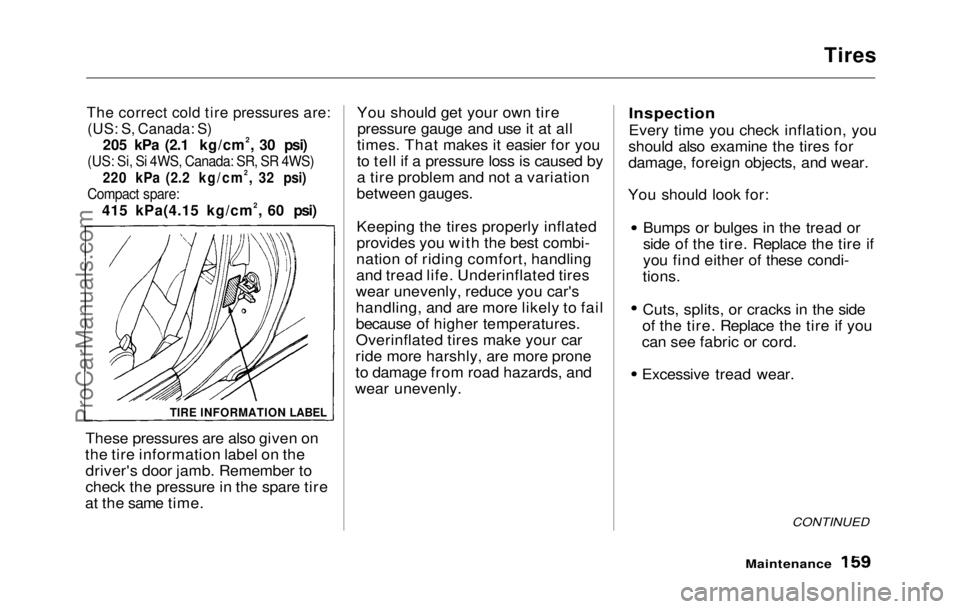Page 156 of 225

Engine Belts, Tires
Engine Belts
Check the condition of the two
engine belts. Examine the edges of
each belt for cracks or fraying.
Check the tension of each belt by pushing on it with your thumb
midway between the pulleys.
The belts should have the following "play" or deflection.
Alternator belt:
10.0 — 12.0 mm (0.39 — 0.47 in)
Power steering belt:
13.5 — 16.5
mm
(0.53
—
0.65 in)
If you see signs of wear or loose-
ness, have your dealer adjust or
replace the belts. Your dealer will
check these belts as part of the
normal scheduled maintenance.
Tires
Check the inflation and condition
of your car's tires at least once a
month.
Inflation
Check the pressure in the tires
when they are cold. This means the car has been parked for at least
three hours. If you have to drive
the car before checking the tire
pressure, the tires can still be
considered "cold" if you drive less than one mile.
If you check the pressure when the
tires are hot (the car has been
driven several miles), you will see
readings 28 to 41 kPa (0.3 to 0.4
kg/cm2, 4 to 6 psi) higher than the
cold reading. This is normal. Do not
let air out to match the specified
cold pressure. The tire will be
underinflated.
Maintenance
POWER STEERING BELT
ALTERNATOR
BELTProCarManuals.comMain Menu Table of Contents s t
Page 157 of 225

Tires
The correct cold tire pressures are:
(US: S, Canada: S)
205 kPa (2.1 kg/cm2, 30 psi)
(US: Si, Si 4WS, Canada: SR, SR 4WS)
220 kPa (2.2 kg/cm2, 32 psi)
Compact spare:
415 kPa(4.15 kg/cm2, 60 psi)
These pressures are also given on
the tire information label on the driver's door jamb. Remember to
check the pressure in the spare tire
at the same time. You should get your own tire
pressure gauge and use it at all
times. That makes it easier for you
to tell if a pressure loss is caused by
a tire problem and not a variation
between gauges.
Keeping the tires properly inflated
provides you with the best combi-
nation of riding comfort, handling
and tread life. Underinflated tires
wear unevenly, reduce you car's
handling, and are more likely to fail
because of higher temperatures.
Overinflated tires make your car
ride more harshly, are more prone
to damage from road hazards, and
wear unevenly.
Inspection
Every time you check inflation, you
should also examine the tires for
damage, foreign objects, and wear.
You should look for:
Bumps or bulges in the tread or
side of the tire. Replace the tire if
you find either of these condi-
tions. Cuts, splits, or cracks in the side
of the tire. Replace the tire if you
can see fabric or cord.
Excessive tread wear.
CONTINUED
Maintenance
TIRE INFORMATION LABELProCarManuals.comMain Menu Table of Contents s t
Page 221 of 225

Index
Ignition
Keys.............................................. 47
Switch.......................................... 47
Timing Control System........... 212
Indicator Lights,
Instrument
Panel............................................. 31
Infant Restraint.............................. 19
Inflation, Proper Tire..................
158
Inside Mirror...................................
59
Inspection, Tire.............................
159
Instrument Panel............................
30
Instrument Panel Brightness....... 41
Interior Cleaning..........................
179
Interior Lights................................
66
Introduction........................................ i
Jacking up the Car.......................
185
Jack, Tire...................................... .
185
Jump Starting...............................
.
191
Keys.................................................. 4
7
Label, Certification...................... 204
Lane Change, Signaling................ 41
Lap/Shoulder Belts......................... .
6
Leaking of Exhaust into Car........ 25
Lighter, Cigarette.......................... 65
Lights
Bulb Replacement.................... 164
Indicator....................................... 3 1
Parking........................................
. 40
Turn Signal.................................. 41
Loading Cargo..............................
106
LOCK (Ignitio n
Key Position).....
47
Locks
Anti-theft Steerin
g Column..... 47
Fuel Filler Door........................
100
Glove Box................................... .
62
Power Door.................................. 48
Trunk...........................................
50
Low Coolan t
Level.......................
139
Lower Gear
,
Downshifting to a . 112
Low Oil Pressure Light........ 33, 195
Lubricant Specifications Chart.
206
Luggage.........................................
106
Maintenance.................................. 127
Periodi
c Items........................... 133
Record................................. 131-
132
Schedule ............................ .
128-129
Manual Transmission..................
111
Manual Transmissio n
Fluid.......
145
Maximum Shif
t
Speeds....... 112, 115
Meters, Gauges............................... 37
Methanol in Gasoline..................... 98
Mirrors, Adjusting......................... 59
Neutral Gear Position..................
114
New Vehicl e
Break-in................... 98
Normal Shift Speeds....................
111
NOTICE, Explanatio n
of................ ii
Numbers, Identification..............
204
Occupant Protectio n
System ......... 4
CONTINUEDProCarManuals.comMain Menu s t